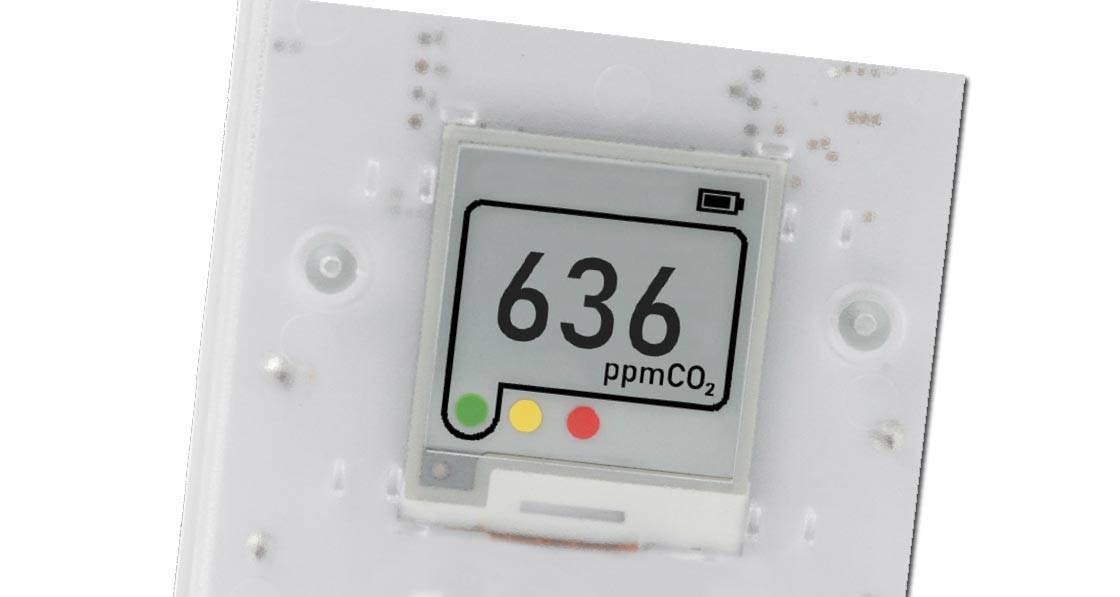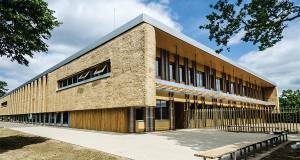
- coronavirus
- Posted
Growing use of CO2 monitors to slow Covid spread
While the Irish government is delivering CO2 monitors to schools to help prevent the spread of Covid-19, and some European regions have mandated the use of such monitors in all buildings open to the public, the UK has yet to introduce such measures and has removed the requirement for mask-wearing in schools.
This article was originally published in issue 38 of Passive House Plus magazine. Want immediate access to all back issues and exclusive extra content? Click here to subscribe for as little as €10, or click here to receive the next issue free of charge
The Irish government is to provide CO2 monitors to all primary and secondary schools, and will support schools that need to upgrade their ventilation to help protect against airborne transmission of Covid.
The announcement came as the US Centres for Disease Control (CDC) published research suggesting that increasing ventilation may reduce Covid infection in schools by as much as 35 per cent.
Meanwhile, the UK government is under increasing criticism for failing to implement equivalent mitigation measures, and for actually removing the requirement to wear masks in schools in England, at a time when incidence of the highly infectious Covid Delta variant was rising more quickly among school age children than any other age group.
The importance of ventilation and maskwearing in limiting Covid transmission in schools was highlighted by the findings from a US study.
One hundred and seventy US schools responded to a survey about mask wearing, ventilation and air cleaning practices, and responses were compared against the official records for school Covid outbreaks, and against the community Covid incidence rates locally at that time.
Around half the schools reported that steps had been taken to increase ventilation, and in these schools, there were 35 per cent fewer outbreaks. Air cleaning (for example via HEPA filtration) appeared to reduce the risk still further, to 48 per cent below the ‘no measures’ level, but numbers here were quite small, so this result is less clear.
Mask wearing also showed a strong protective effect, with schools that required staff to wear masks reporting 37 per cent fewer outbreaks. The effect of mask wearing by children did not appear as strong.
Irish schools
In May, Ireland’s Department of Education announced that “to support schools... to identify rooms which may have inadequate ventilation and to optimise comfort levels” it would provide CO2 monitoring units over the coming months. These monitors are expected to flag when CO2 levels rise to anything above 800 parts per million (ppm), though the recommended “action level” is higher at 1,400 - 1,500 ppm. The use of CO2 monitors is seen as a simple way of showing how well a space is ventilated. Lack of fresh air ventilation in buildings is associated with increased spread of Covid-19 and super-spreader events.
The department has advised schools to check that its ventilation is adequate, and if it is not, it will offer support to install or upgrade equipment. “Schools that identify inadequate ventilation in a room can utilise their minor work grant (for minor improvements) or apply for emergency works grant assistance to address ventilation enhancements on a permanent basis,” it said.
A spokesperson for the department told Passive House Plus that it was finalising a traffic light type system “with the expectation of having three or four settings from 800 ppm upwards”.
The accompanying guidance advises schools to increase ventilation in a room if CO2 levels rise above 1,400 ppm. This is the “action level” also recommended by the UK’s Scientific Advisory Group on Epidemics (SAGE).
The Irish education department also cites SAGE advice that “A consistent CO2 value < 800 ppm (absolute value) is likely to indicate that a space is well ventilated, but does not mean that an environment is risk free of COVID-19 risks”.
The move by the Irish government follows advice earlier in the year from the country’s Expert Group on the Role of Ventilation in Reducing Transmission of Covid-19. The group’s report recommended that schools should receive clear advice on ventilation, and that CO2 monitoring equipment should be made available.
CO2 monitors in the classroom
Cath Jones teaches in a typical English rural primary school – a Victorian stone building with high ceilings, and high windows, but no mechanical ventilation. To help prevent the spread of Covid-19, her school took matters into its own hands and bought a CO2 monitor.
“After a conversation with friends about Covid and airborne transmission last autumn, I broached the idea of using a CO2 monitor with a colleague. He was fascinated by the idea and did some research of his own.
“The school discussed the idea and the finance officer was asked to look into it. They found a relatively cheap monitor – quite basic. And we put it in the classroom. We set a level based on our reading around – though this was really used just as an indicator, we knew the monitor would not be that accurate.
The upper limit we set was very rarely reached, in fact. “The windows were always open a little, but the kids in class were very observant, and when levels rose they would say ‘Sir, sir it’s going up’, and the windows would be opened more widely.
“If levels hit our limit we had a ‘purge’: everyone would go outside for five minutes with all doors and windows thrown open, and return when CO2 levels in the classroom had gone back down close to ambient.
“The class teacher was very happy, as social distancing is very difficult for us. The classrooms in our school are small: we were supposed to be maintaining two metre distancing but we physically could not do it. There are generally four adults in the classroom (as extra support for pupils) so the teacher felt this was a valuable additional protection measure.”
The children (aged around eight to ten) really liked it, and took ownership, Cath found. “If a different teacher came in – for example, I take that class on one afternoon a week — the kids would point rising levels out to the visitor: ‘Miss Jones, do you think we should open the windows?’ It gave them a bit of responsibility, to check the levels, they really took to it.”
Achieving this level of ventilation came at the cost of thermal comfort. “We were all in thermals until the end of May. It was perishing.” But Cath and her colleagues are sanguine about this, especially in view of the fact that Covid transmission in her school has, so far, not been reported at all.
John Wenger, professor of chemistry at University College Cork and chair of the expert group, welcomed the announcement. He told Passive House Plus in an email: “I am delighted that the Department of Education (DoE) in Ireland has responded positively to the recommendations contained in our reports.
“The Group had a good level of engagement with the DoE, and are very pleased with the updated guidance on ventilation and especially the provision of CO2 monitors to schools.”
He added that his personal advice is always to keep indoor CO2 levels below 800 ppm and to open more doors and windows to reach this level. But he added that it may not always be possible to achieve this, or achieve it comfortably, in a naturally ventilated building.
The Teachers Union of Ireland also welcomed the move, but pointed out that the need for such measures had been clear to them and their members as early as the start of the academic year (September 2020). Summarising the results of a teacher survey, the union said last autumn: “Ventilation problems will now become critical as we move towards colder weather. Many schools, particularly those based in older buildings, will require new ventilation solutions and there will also be a need for monitors to signify when air exchange is required.”
Hospitality
Meanwhile, updated Covid guidance for the hospitality and leisure industries was also released in Ireland at the start of June by Fáilte Ireland, the national tourist board. As with the guidance for schools, businesses are advised what steps should be taken to increase ventilation. However, unlike in schools, and the hospitality sector in some other European nations (see ‘Scores on the doors’) Fáilte Ireland stopped short of recommending CO2 monitors. There is also considerable emphasis on cleaning regime.
University College Dublin immunologist Dr Gerald Barry welcomed the new guidance. However, he told the Irish Times that he felt there was still insufficient emphasis on air movement, which he believes is “far more important in mitigation than Perspex screens or hand sanitiser”.
UK guidance
In the UK, the Delta variant of Covid was increasing faster in school age children than any other group at the time of writing, in mid-June. However, the government recently reversed its requirement for secondary school children in England to wear masks in school, and is not offering support either for CO2 monitors or for upgrading inadequate ventilation, despite numerous calls for it to do so.
The UK’s Department for Education makes similar recommendations to those in Ireland on window opening and maximising fresh air flow though mechanical systems. However, although its advice refers to CIBSE guidance (which suggests CO2 levels be brought below 1,400 ppm), there is no specific suggestion that UK schools use monitors to check ventilation effectiveness. Experts have been calling for school ventilation to be upgraded on a national basis, and for CO2 monitors to made available in UK schools.
Professor Christina Pagel of University College London is one of many experts concerned about this inaction, especially in the light of what appears to be “significant transmission” of the Delta variant in UK schools.
“We need to address this with mitigations in schools ASAP to stop disruption to education and wider spread,” she said on Twitter.
Her view echoed an editorial on 1 June in the British Medical Journal by Dr Deepti Gurdasani, senior lecturer in epidemiology at Queen Mary University London, and colleagues. The editorial said that even at the time, it had been clear that removing the requirement for face coverings in secondary schools in England was ill advised “given the clear evidence for the role of children and schools in transmission of SARS-CoV-2 and the rise of the new variant”. The group added that as well as the re-instatement of masks, “there needs to be central investment in ventilation and air cleaning in schools, including CO2 monitors, and air filtration devices, to supplement ventilation where needed.”
Passive House Plus asked if the UK government planned to follow the example of Ireland and offer support to schools to upgrade ventilation, and make CO2 monitors available, but the department did not respond specifically to this question.
Some schools have independently purchased CO2 monitors [see ‘CO2 monitors in the classroom’], but their purchase and use is discretionary. Many UK schools are reportedly focusing resources on surface cleaning and hand sanitising instead.
It is not clear exactly how much of the current spread of the Delta variant in the UK is occurring via school outbreaks, because detailed data is not currently being published by public health authorities in England.
‘Scores on the doors’– making CO2 monitors mandatory in public buildings
Regulatory authorities around the world are being urged to follow the example of pioneering countries like Spain, Belgium and Canada, and require the display of live CO2 monitoring in buildings open to the public.
The 40-strong team, from disciplines including public health, infectious diseases, respiratory medicine, epidemiology and engineering, pointed out that there are strict controls on food, water and sanitation, in order to prevent mass outbreaks of dangerous infections. They warn that we are yet to take air quality as seriously, despite its obvious impact on the spread of deadly diseases such as Covid-19.
“Wide use of monitors displaying the state of IAQ [indoor air quality] must be mandated. At present, members of the general public are not well aware of the importance of IAQ and have no means of knowing the condition of the indoor spaces that they occupy and share with others,” they write.
“Visible displays will help keep building operators accountable for IAQ and will advance public awareness, leading to increased demand for a safe environment.”
Regulation of air quality, and the requirement for publicly visible monitors, is now required in some countries. In Belgium, and a number of provinces in Spain, including the Balearic Isles and Asturias, businesses such as hospitality and indoor gyms are required to display a CO2 monitor, and to keep CO2 below a set level (in Asturias this is a challenging 800 parts per million).
In North America, the focus is schools. For example, every classroom in Quebec will be provided with CO2 monitors to "ensure optimal indoor air quality". Meanwhile in New York, every room in every school has its ventilation assessed, and the results are displayed online.
Related items
-
 King of the castle
King of the castle -
 Energy poverty and electric heating
Energy poverty and electric heating -
 New Ejot profile cuts thermal bridging losses by 25mm insulation equivalent
New Ejot profile cuts thermal bridging losses by 25mm insulation equivalent -
 Build Homes Better updates Isoquick certification to tackle brick support challenge
Build Homes Better updates Isoquick certification to tackle brick support challenge -
 #BuildingLife Series: Director at CORA Consulting Engineers, John Casey
#BuildingLife Series: Director at CORA Consulting Engineers, John Casey -
 September’s AECB environmental construction conference seeks to spark debate among industry experts
September’s AECB environmental construction conference seeks to spark debate among industry experts

